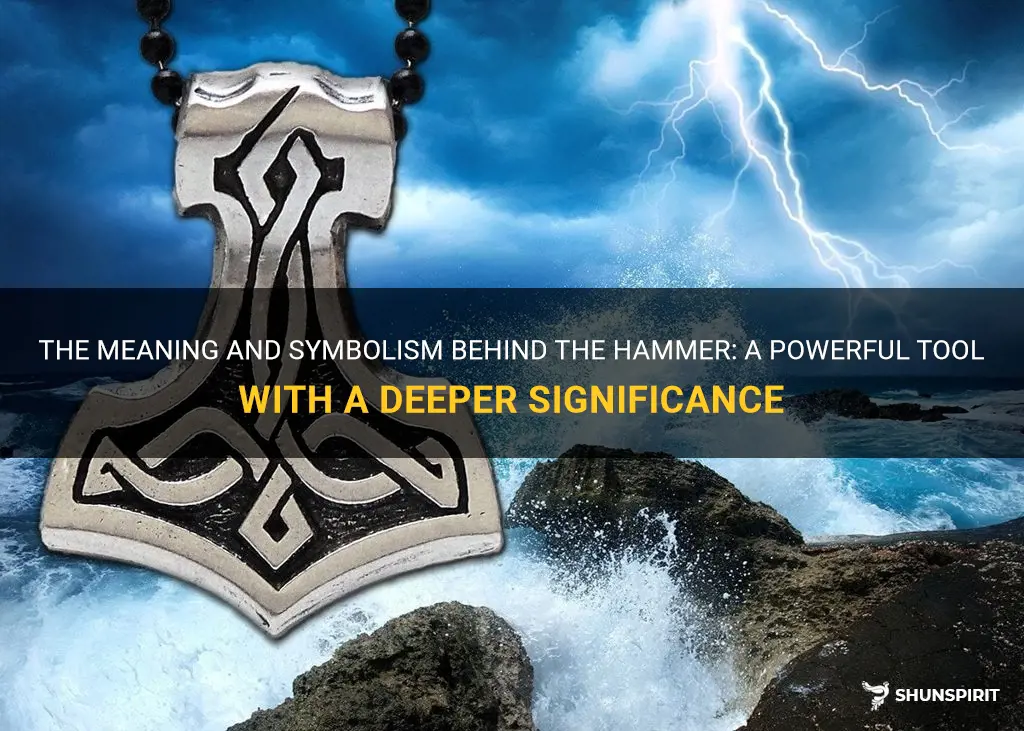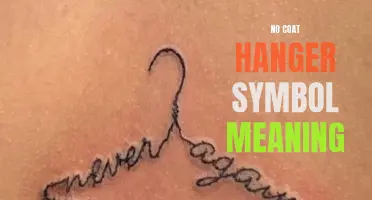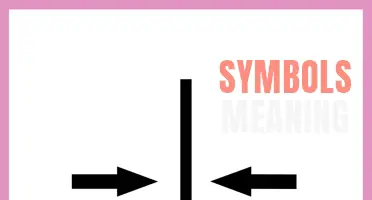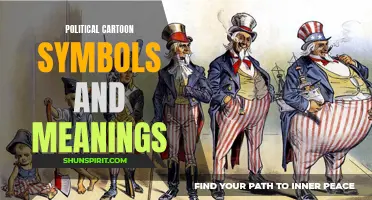
The hammer is a powerful tool that has been used for countless years in various cultures and industries. It is a symbol of strength, determination, and hard work. From the blacksmith's forge to the construction site, the hammer embodies the idea of shaping and creating with force and precision. But beyond its practical uses, the hammer also holds symbolic meanings that delve into the depths of human existence. In this article, we will explore the diverse symbolisms associated with the hammer and uncover the hidden messages it conveys in different contexts. So grab your tool belt and join us on a journey through the fascinating world of hammer symbolism.
What You'll Learn
- What is the symbolic meaning of the hammer symbol?
- In what cultures or religions is the hammer symbol significant and what does it represent?
- How has the meaning of the hammer symbol evolved over time?
- Are there any famous myths or stories associated with the hammer symbol?
- Can the hammer symbol also hold personal or individual meanings for people, and if so, what are some possible interpretations?

What is the symbolic meaning of the hammer symbol?
The hammer symbol holds great significance in various cultures and has been used as a symbolic tool for centuries. It represents strength, power, determination, and protection. The hammer is often associated with gods, heroes, and legendary figures who possess these qualities.
In Norse mythology, the hammer symbol is most famously associated with Thor, the god of thunder. Thor's hammer, Mjölnir, was a fearsome weapon that was said to harness the power of thunder and lightning. It represented not only Thor's strength but also his ability to protect and defend the gods and humankind from evil forces. Mjölnir was also a symbol of fertility and was used in various rituals and ceremonies.
The hammer symbol is also significant in Celtic culture. The Celtic god Sucellos, who was associated with agriculture, the underworld, and prosperity, was often depicted holding a hammer. This symbolized his powers of fertility and abundance, as well as his ability to bring forth bountiful harvests.
In ancient China, the hammer was a symbol of luck and protection. It was believed that a hammer-shaped amulet could ward off evil spirits and bring good fortune. The hammer motif was also commonly used on Chinese architectural structures and household items as a protective symbol.
In addition to its association with gods and legends, the hammer symbolizes hard work, determination, and craftsmanship. It represents the power to shape and create. This is evident in the use of hammers in various trades and professions, such as blacksmithing, construction, and metalworking. The hammer is a tool that requires strength and skill to wield effectively, making it a fitting symbol for those who work diligently and strive for excellence.
Overall, the hammer symbol holds deep cultural and symbolic meaning across different civilizations. It represents strength, power, protection, fertility, and craftsmanship. It is a symbol that embodies the qualities and values that humans have admired and revered for centuries. Whether as a symbol of a god's might or a reminder of the power of hard work, the hammer continues to be an enduring and meaningful symbol in various aspects of life.
Unveiling the Symbolism Behind Advent’s Sacred Symbols
You may want to see also

In what cultures or religions is the hammer symbol significant and what does it represent?
The hammer symbol holds different meanings across various cultures and religions around the world. In Norse mythology, the hammer symbol is particularly significant and represents the mighty weapon of Thor, the god of thunder.
In Norse mythology, Mjolnir is the name of Thor's hammer. It is one of the most powerful weapons in this mythological system and is closely associated with protection, strength, and the ability to defeat evil forces. Mjolnir is often depicted as a short-handled hammer with a large head, and it is believed to possess the power to control lightning and stormy weather. The hammer symbolizes Thor's ability to protect the gods and humanity from various threats, making it a symbol of security and defense.
The hammer symbol is also present in other cultures and religions. In ancient Celtic mythology, the hammer is associated with the god Taranis, who represents thunder and lightning. The hammer symbolizes Taranis' power over the natural elements and is believed to grant protection and prosperity. It serves as a symbol of authority and the ability to control destructive forces.
In some Native American cultures, the hammer symbol is associated with the Thunderbird, a powerful deity often depicted as a large bird or bird-like creature. The Thunderbird is believed to control lightning and storms, similar to Thor in Norse mythology. The hammer symbolizes the Thunderbird's ability to bring rain and fertility to the land, ensuring the prosperity of the people and their crops.
In addition to its mythological significance, the hammer symbol holds cultural and historical meaning as well. In many ancient societies, including the Vikings, hammers were used as tools for construction, forging, and craftsmanship. As such, the symbol of a hammer often represents skill, craftsmanship, and creation. It is a symbol of hard work and dedication to one's craft.
Furthermore, the hammer symbol is also associated with justice and authority. In heraldry, the hammer is a common symbol used to represent blacksmiths or anyone associated with metalworking. It stands for determination, perseverance, and fairness in ruling. For instance, the hammer is used as a symbol in the legal profession, representing the authority of judges and their ability to render fair judgments.
In conclusion, the hammer symbol holds various meanings across different cultures and religions. In Norse mythology, it represents Thor's mighty weapon and is associated with protection and the defeat of evil forces. In Celtic mythology, the hammer symbolizes Taranis' power over thunder and lightning. In some Native American cultures, the hammer represents the Thunderbird's control over storms and fertility. Additionally, the symbol has cultural and historical significance, representing craftsmanship, hard work, justice, and authority. These diverse interpretations of the hammer symbol highlight its importance in various belief systems around the world.
The Deep and Symbolic Meaning Behind Rammstein's Iconic Symbol
You may want to see also

How has the meaning of the hammer symbol evolved over time?
The hammer symbol has a rich history and has evolved in meaning over time. What was once a simple tool used for construction and manual labor has become a potent symbol of power, authority, and rebellion. The hammer has been associated with various movements, such as communism, craftsmanship, and even heavy metal music. Let's explore how the meaning of the hammer symbol has evolved over time.
In ancient times, the hammer was primarily used as a tool for pounding and shaping materials like wood and metal. It was an essential tool for construction, blacksmithing, and other forms of manual labor. The hammer was seen as a symbol of strength, hard work, and craftsmanship.
During the Middle Ages, the hammer took on a new meaning in the form of Thor's Hammer, also known as Mjölnir. In Norse mythology, Mjölnir was the weapon of Thor, the god of thunder. It represented protection, strength, and the power to command thunder and lightning. This association with divine power and protection gave the hammer a mythical aura.
Fast forward to the 19th and 20th centuries, and the hammer began to take on political connotations. In the late 19th century, the hammer and sickle became the iconic symbol of communism. The hammer represented industrial workers and their power, while the sickle symbolized the agricultural workers. Together, they stood for the unity of the working class and their struggle against the bourgeoisie. This symbol was widely adopted by socialist and communist movements worldwide.
In addition to its political significance, the hammer continued to represent craftsmanship and skilled labor. Artisans, blacksmiths, and other craftsmen used the hammer as a symbol of their trade. It became an emblem of quality, precision, and mastery over one's craft.
In recent times, the hammer has also been appropriated by various counterculture movements. Heavy metal music, for example, has embraced the hammer as a symbol of rebellion and non-conformity. The hammer is often combined with other imagery like skulls, flames, or lightning to convey a sense of power and strength. It has become a potent symbol of the rebellious spirit and the rejection of societal norms.
Today, the meaning of the hammer symbol continues to evolve. It remains a symbol of strength, hard work, and craftsmanship, but it has also taken on new connotations in the realms of politics and counterculture. Whether it's a tool for construction, a political emblem, or an icon of rebellion, the hammer symbol will always carry a sense of power and authority. Its ability to adapt and evolve over time is a testament to its enduring significance.
Exploring the Intriguing Meanings Behind Arabic Symbols
You may want to see also

Are there any famous myths or stories associated with the hammer symbol?
The hammer symbol has been used throughout history in various cultures and religions and has often been associated with power, strength, and protection. In Norse mythology, the hammer symbol is closely linked to the god Thor and has its own famous myth associated with it.
In Norse mythology, Thor is the god of thunder and a protector of both gods and humans. He is often depicted carrying his mighty hammer, Mjölnir, which is said to have been forged by the dwarves. Mjölnir is one of the most famous symbols in Norse mythology and is known for its power to destroy and create.
There are several myths and stories associated with Thor and his hammer. One of the most well-known stories is the theft of Mjölnir by the giant Thrym. According to the myth, Thrym was the king of the giants and had a deep desire to marry the goddess Freyja. When he was refused, he devised a plan to steal Mjölnir and hold it for ransom.
Thrym hid Mjölnir deep underground and demanded that it be returned only if Freyja agreed to marry him. The gods were horrified by the theft of the hammer, as it meant that they were defenseless against the giants. They turned to Loki, the trickster god, for help, and he devised a plan to retrieve the hammer.
Loki instructed Thor to dress as Freyja and go to Thrym's hall to retrieve the stolen hammer. Thor was initially reluctant to go along with the plan, as it involved dressing in women's clothing, but he eventually agreed. When Thor arrived at the hall, Thrym was overjoyed and ordered a great feast to celebrate his impending marriage to Freyja.
During the feast, Thor's true identity was revealed when he devoured an entire ox in a single bite. Angered by the deception, Thor retrieved Mjölnir from its hiding place and used it to vanquish Thrym and his giant kin. This myth not only highlights the power of Mjölnir but also showcases Thor's strength and his willingness to go to great lengths to protect the gods and humans.
The hammer symbol, particularly Mjölnir, has become a popular symbol in modern culture. It is often associated with strength, courage, and protection. In Norse mythology, it was believed that Mjölnir had the power to ward off evil and protect its wielder. Today, many people wear Mjölnir pendants or other hammer symbols as a representation of these attributes.
The hammer symbol has a rich history and is associated with various myths and stories across different cultures. From Norse mythology and the famous myth of Thor and his hammer to its modern-day symbolism, the hammer continues to be a powerful and iconic symbol of strength and protection.
The Intriguing Symbolism Behind the Three Wavy Lines
You may want to see also

Can the hammer symbol also hold personal or individual meanings for people, and if so, what are some possible interpretations?
The hammer is a symbol that has deep cultural, historical, and even mythological importance. It has been used throughout various civilizations to represent strength, power, and authority. However, beyond its universal meanings, the hammer can also hold personal or individual significance for people, with each person interpreting it in their own unique way. Here are some possible interpretations of the hammer symbol:
- Hard work and labor: The hammer is often associated with physical labor and hard work. It represents the efforts and skills required to create or build something. For individuals who value hard work and dedication, the hammer can be a reminder of the importance of putting in the necessary effort to achieve their goals.
- Achievement and success: In some cultures, the hammer is seen as a symbol of achievement and success. It represents the ability to overcome obstacles and accomplish great things. For individuals who have achieved their goals or are striving for success, the hammer can serve as a reminder of their accomplishments or as motivation to continue working towards their dreams.
- Protection and defense: The hammer is also associated with protection and defense. In Norse mythology, Thor, the god of thunder, wields a hammer called Mjolnir, which is said to protect the gods and humans from enemies and evil forces. For individuals who value personal safety and protection, the hammer can be seen as a symbol of strength and security.
- Creativity and craftsmanship: The hammer is a tool commonly used by craftsmen and artisans. It represents the ability to create and transform raw materials into something beautiful or functional. For individuals who are creative or enjoy working with their hands, the hammer can symbolize their artistic or craftsmanship abilities.
- Masculinity and masculinity: Historically, the hammer has been associated with masculinity and male strength. It represents power, authority, and physical might. However, this interpretation may vary depending on cultural and societal contexts. For some individuals, the hammer may symbolize traditional gender roles, while for others, it may represent a more inclusive and diverse understanding of gender and strength.
- Justice and equality: In some contexts, the hammer symbolizes justice and equality. It is often associated with the scales of justice and represents the power to enforce fair and impartial decisions. For individuals who are passionate about social justice and equality, the hammer can serve as a reminder of the importance of standing up for what is right and fighting against injustice.
Overall, the hammer symbol can hold multiple personal meanings for different individuals. It is a versatile symbol that can represent various aspects of life, including hard work, achievement, protection, creativity, masculinity, justice, and equality. The interpretation of the hammer symbol ultimately depends on an individual's personal experiences, beliefs, and values.
Exploring the Symbolic Meaning of Bronze in the Bible
You may want to see also
Frequently asked questions
The hammer symbol often represents strength, power, and industriousness. It is often associated with hard work and productivity.
The hammer symbol is found in various cultures and holds different meanings. In Norse mythology, the hammer symbol known as Mjolnir was associated with the god Thor and represented protection and consecration. In Celtic cultures, the hammer symbol was called the "thunderbolt" and was associated with the sky god Taranis.
The hammer and sickle symbol is the most recognizable symbol of communism. The hammer represents the industrial proletariat, and the sickle represents the agricultural peasantry. The symbol was first used during the Russian Revolution and has since become associated with socialist and communist movements worldwide.
While the hammer symbol is often associated with positive qualities such as strength and industriousness, it can also carry negative connotations. For example, the hammer and sickle symbol has been associated with oppressive communist regimes. Additionally, in some contexts, the hammer symbol can represent violence and destruction.







